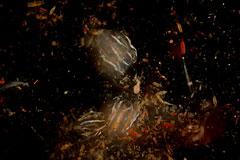

 | |||||||||||||
|
|
Journals 2007/2008Jason Pavlich
December 27, 2007 Position 71° 15.673' N 124° 37.480' W I spent some time on the ice today, though not for sampling as I originally anticipated. At 3:15 pm the ships alarm bells and sirens sounded, signaling our first major drill. We all did as instructed- dropped everything, proceeded back to our room, dressed warmly, grabbed our lifejackets (even though the ocean is quite frozen here), headed outside using the first available exit, and assembled at the helicopter deck as soon as possible. Role call was taken and we were instructed to leave the ship, as would happen if we encountered a fire while on the ice. We huddled together about 100 m from the ship for about 30 minutes while the crew went through their exercises as well. A second role call was performed to make sure no one was lost on the ice and we made our way back to the ship. The rest of my day was primarily spent in the lab, helping Wojciech and Monika separate out the species of copepods for his experiment. They are studying the retention and absorption of HCHs by the species Calanus hyperboreus. This species of copepods makes their way toward the surface waters in the spring and summer months when the plentiful sunlight fuels the phytoplankton that are their main food source. In the fall and winter, they drop deeper in the water column, theoretically taking with them any contaminants they picked up at the surface. It is this exchange and that interests Wojciech and Monika. They might like to eventually expand the study to other related species, but right now that is not practical. Think big, start small.
I am getting quite good at telling them all apart, though I have yet to master the naming system. It is amazing how much life there is in the water and that some of it is eating each other in the Petri dish in front of me. Watching this and looking at the various zooplankton under the microscope makes me think twice about ever swimming in the ocean again. It is 11 pm now and since I started writing, the coordinates I recorded at the top of this page have changed- a lot. Even though we are stationary relative to the large piece of ice we are sitting in, we are drifting west fast. Although the outside temperature is not too bad at -21.0°C, the wind is topping out at 30 knots (about 34 mph). On the bridge, you can hear the wind howl around the ship. David, the officer on watch right now, tells me that the wind chill factor outside is about -51°C, or -60°F. He adds that at this temperature, exposed flesh will freeze in minutes. Needless to say, work outside has stopped for the night. 124° 38.635' W and counting. I wanted the Arctic and it looks like I got it. |
||||||||||||

